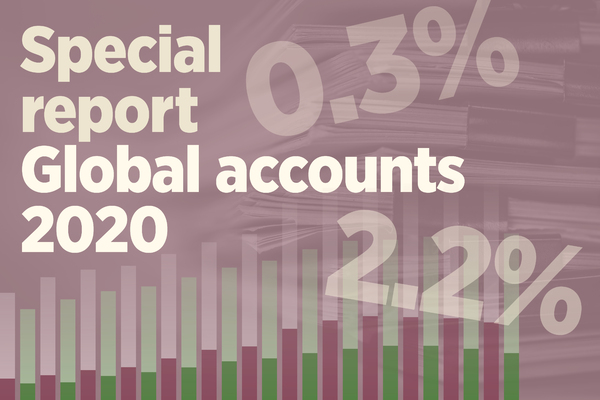How can the social housing sector make the most of sustainable finance?
As associations face up to the costs of decarbonising their housing stock, the sector’s ESG credentials offer a valuable, though not uncomplicated, opportunity for accessing sustainable finance
In association with:
![]()
Sustainable finance gives the social housing sector an opportunity to build cleaner, greener homes and create better futures for tenants. Brendan Sarsfield, chair of the Sustainability for Housing Board, and Gayle Monk, senior associate at Anthony Collins, share their views on the task ahead for providers. And we hear from Orbit Group and Nottingham Community Housing Association about their projects that demonstrate the practical applications of funding approaches.
Comment: social housing’s new era

Now more than ever, we need to be outward-looking and talk collectively as a sector, says Brendan Sarsfield
With my tenure as Peabody chief executive now ended, I’ve been reflecting on where the sector is today and the challenges it faces in the future, especially in connection to one of my new jobs as chair of the Sustainability for Housing Board.
The social housing sector is full of great people trying to do a great job and we should never forget that. But we have to recognise the size of the problems we are trying to solve is growing quicker than our solutions.
We don’t have enough homes in the UK, rough sleeping homelessness is rising, the gap between the incomes of our residents and the average income is growing, and there are not enough resources to provide decent care and support for those in the greatest need. We also operate in a broken housing system and a failing construction industry.
That’s not to say this is everybody else’s fault. The sector contributes towards some of these problems and many recent criticisms directed at us are valid. This is why we must learn from our mistakes quickly to improve.
“Priorities and capabilities will change at a time when political rhetoric and the need to find people to blame will be at its highest point. This will require different leadership styles and excellent communication skills”
We must be more aligned with our residents, a little less naïve about some of our partnerships (if in doubt, read the transcripts from the Grenfell Inquiry), and be more honest about the challenges we face in delivering our homes and services. Fortunately, the sector is full of people keen to improve, so we need to align and unlock that potential to play a bigger part in solving these problems.
At the same time, social landlords are moving into a new era where different strategies, skills and approaches will be needed to deliver great outcomes. The fire safety and carbon neutral challenges are huge and changing the sector’s priorities. As the horizon changes from maintaining existing homes to the more expensive ambition of improving them, increasing supply will become ever more challenging for social landlords, as well as local and central government and Homes England.
Historically, many housing associations have taken big risks on the building of new homes and loaded their balance sheets with debt to try and reduce homelessness. But, in the future, that load is going to have to be shared by many others, some of whom will be new participants from public and private sectors, with different cultures and practices.
Housing associations will soon be redefining their role in this new mixed economy, if they haven’t done so already – perhaps stepping up if they have low debt, or stepping back/changing roles if they have been subsidising new homes for many years.
Climate change
Climate change is going to generate political heat as well as a warmer world and the role played by the housing sector will come under increasing scrutiny from politicians and the public (including residents and staff).
Homes contribute significantly to carbon emissions in the UK. The clock is ticking on addressing this and landlords will be juggling the challenges of imperfect data, unknown costs, supply chain shortages and the need for technology that hasn’t yet been invented with the urgent need to start improving homes. How, then, are organisations going to manage the increased scrutiny from politicians, press and the public all looking for someone to blame? And how are they going to position themselves to be part of the solution, not the problem?
“Are you ready for this new world? I would be surprised if anyone is confident that they are, but we have to start the journey”
Priorities and capabilities will change at a time when political rhetoric and the need to find people to blame will be at its highest point. This will require different leadership styles and excellent communication skills.
Are you ready for this new world? I would be surprised if anyone is confident that they are, but we have to start the journey. The worst thing you can do is nothing, which brings me to the world of finance and environmental, social and governance (ESG) principles.
ESG finance
The finance sector is going through big changes, too. There are political and ethical pressures on lenders to invest in organisations that solve world problems rather than create them, and the dust hasn’t yet settled on what this will mean in the long term.
At the moment, ESG finance is offering financial incentives to borrowers that can demonstrate an investment can make a real difference. But this is a side story; the longer-term picture is that ESG finance may soon be the main type of funding available, with strings attached.
The main change is lenders will want to know more about your organisation than they currently do. They will want big-picture ideas and examples that add colour and explanation. They will want to know what you are trying to do and where you need help from others to achieve your goals. How you will succeed and the risks of failure will also be of interest.
It isn’t complicated and it’s exactly what your other stakeholders will want, too. ESG reporting isn’t really financial reporting, it is a corporate reporting tool for all stakeholders. In fact, one chief financial officer recently said to me that if your ESG report isn’t understood and recognised as real by your residents, it doesn’t work for lenders either. One lender said to me that if you need one report for residents and one for the banks, then you must be greenwashing.
The ESG reporting standards, created by the housing association and finance sector, help you do two things. Firstly, they help you tell your stories. Secondly, they help manage the interface with the finance world. If we can get a single view from the majority of lenders on what they want to know, that will save us the bureaucracy of producing multiple reports and improve communication.
However, we must collectively agree to give them that information. The standards won’t work if they are not adopted by the majority. If they don’t work for you, please help shape the next version so they improve.
A single sector story
The final point I want to make is that, in these times of change and increased pressure from all stakeholders, now more than ever, we need to be outward-looking and talk collectively as a sector.
We are a traditionally inward-looking sector that thinks we are all unique players. Yet the outsider can’t tell the difference between us except by our size. We need to tell a single sector story for the collective good.
The National Housing Federation will obviously play a critical role in collecting our stories to paint an overall picture and help us communicate better, but it needs our help and commitment to do that. The Sustainability for Housing standards will also play an important role in collaboration and communication with the finance sector and I urge those who have yet to engage with us to reach out and talk to me or my fellow board members.
Overall, it’s vital we work together to make these sustainability and wider sector targets a reality. Put simply: we will have one voice or no voice at all.
Brendan Sarsfield, chair, Sustainability for Housing Board
Comment: delivering net zero
For the social housing sector, there needs to be more recognition of the value of both environmental and social positive impacts, argues Gayle Monk
Climate change is the most pressing issue affecting human life on the planet. But we should not address this without considering and delivering the wider benefits from net zero, which range from social justice to satisfaction of funding requirements.
Creating net zero carbon homes can have significant and holistic benefits to residents. More efficient homes means lower fuel bills and reduced fuel poverty, better health and an all-round increase in living standards. For the social housing sector, there needs to be greater recognition of the value of both environmental and social positive impacts when making the case for investment.
In its Transforming Public Procurement Green Paper, the government makes the point several times that a more sophisticated approach needs to be taken to setting requirements and the evaluation of tenders to encompass these wider considerations.
While the details have yet to be revealed, the paper says: “The government wants to send a clear message that commercial teams do not have to select the cheapest bid and that they can design evaluation criteria to include wider economic, social or environmental benefits.”
“Creating net zero carbon homes can have significant and holistic benefits to residents”
Although arguably this approach is currently permitted, it is a brave registered provider (RP) that pushes the boundaries. If the government caps the amount disgruntled challengers to procurement processes can claim, then RPs may become bolder. They may take a wider approach to setting requirements and evaluating value, to encompass social outcomes from the net zero agenda, which would maximise value from such investments.
RPs are becoming accustomed to environmental, social and governance (ESG) requirements. Several clients have now entered into funding agreements that discount the cost of funds where the RP manages to deliver against specific ESG targets. In these arrangements, the RP must declare its progress against environmental or social KPIs each year in order to benefit from discounted lending rates.
But when it comes to delivering a net zero carbon housing stock, there are some clear challenges facing the sector. Translating ESG requirements into real results will require government, industry and RPs to deal with:
- The skills and capacity shortages within the supply chain, particularly recognising the impact that the timescales set for use of the Social Housing Decarbonisation Fund are having on
the supply chain’s ability to deliver - The new subsidy control regime, which threatens to unleash a new level of bureaucracy if RPs receive even relatively small amounts of grant (such as the decarbonisation fund)
- The changes to the legal regime around building safety, and the impact that this has on providers’ ability to programme wider work needed on the same properties.
To help tackle these challenges, RPs must be bold in their procurement processes, using an evaluation approach that takes into account wider social and environmental requirements. They should also be aware of their wider policy objectives and any ESG requirements in their funding documents before embarking on any project.
Lastly, it’s critical that RPs address the skills and training agenda, which can be set out as a contract requirement and then evaluated as part of the procurement process. This will build the supply chain capacity needed as delivery ramps up over the next 10 years.
Gayle Monk, senior associate, governance and commercial team, Anthony Collins Solicitors
This article was written in partnership with:
![]()
Case studies: Orbit Group and Nottingham Community Housing Association
Orbit’s retrofit of 69 existing homes in the Stratford-on-Avon region and Nottingham Community Housing Association’s BAME-linked loan facility demonstrate the practical applications of ESG funding
ORBIT GROUP
SUSTAINABLE FUNDING: £1.45M SOCIAL HOUSING DECARBONISATION FUND
USE: CARBON REDUCTION DEMONSTRATOR PILOT
In partnership with Stratford-on-Avon District Council, Orbit Group was successfully awarded £1.45m in January 2021 via the government’s Social Housing Decarbonisation Fund (SHDF) to retrofit 69 of its existing homes in the region.
As part of the deal, which was a local authority-led bid, Orbit invested an additional £2.2m into the project. It was one of 19 demonstrator pilots backed by the government with the aim of determining what carbon reduction measures could be undertaken on current housing stock across the country.
“The key thing that the Department for Business, Energy and Industrial Strategy (BEIS) was trying to demonstrate was scalability in the marketplace and innovation in terms of decarbonisation,” says Jeanette Hodges, head of carbon and operations at Orbit Group.
For Orbit, this meant a deep, whole-house retrofit across the 69 homes, including fabric-first principles such as maximising air tightness via windows and doors, applying loft and external wall insulation and natural ventilation, and installing smart heating controls.
“We’re doing this large programme of works all in one go, while our customers remain living in their homes. We have just appointed a contractor, who is about to start on site, with work due for completion by June next year.
“Planning and communication is key. Critical to the customer is what the changes will look like, how does technology such as smart thermostats work, and will their energy bills be more affordable.”
Explaining the bidding process, Ms Hodges says it was a competitive process, with £60m available as part of the overall funding pot, which they had to apply for last October.
“Critical to the customer is what the changes will look like, how does technology such as smart thermostats work, and will their energy bills be more affordable”
“Eligible properties all had to be in Energy Performance Certificate (EPC) Band D or below and then the BEIS criteria stipulated you had to get them to an EPC Band C and [an annual energy demand target of] 50 kilowatt hours per square metre per annum,” she adds.
An average Orbit property has a current energy demand of 202 kilowatt hours per square metre per annum, meaning the work would result in a 75 per cent reduction in energy demand usage – which Ms Hodges describes as “tight” and “demanding” criteria.
Such government funding also requires Orbit to follow the British Standards Institution’s latest energy efficiency specification and guidance (known as PAS 2035). This means Orbit has to use specific supply chain partners, adding another layer of complexity on the delivery process.
“This means our installers have to be PAS 2030: 2019 qualified, and our contractors have to be PAS 2035 qualified. We then have to have retrofit designers and co-ordinators overseeing the project, as well as carrying out a full energy assessment survey to identify what measures each property needs installing.”
There have been further challenges to turning some of these energy efficiency targets into a reality, including the current market volatility being felt across the country, with contractors struggling to get hold of certain materials and prices rising as a result.
Ms Hodges explains: “We planned to include air source heat pumps, but market volatility has meant that prices came back extremely expensive.
“For us, it was really important that we insulated the 69 homes and protected those families, but we felt it wasn’t good value to spend £16,000 on a heat pump today, when we knew in 12 months’ time it would be £9,000.”
The government is releasing further funding pots in phases. The first of these (now the pilot funding has been allocated, with work under way) totals £160m. Orbit is currently bidding for this funding with a local authority partner.
A further £800m covering the period 2022 to 2025 was also announced in October.
NOTTINGHAM COMMUNITY HOUSING ASSOCIATION
SUSTAINABLE FUNDING: £50M ESG LOAN
USE: BUILD 2,100 HOMES
In January, Nottingham Community Housing Association (NCHA) completed its first loan linked to environmental, social and governance (ESG) principles, which it will use to build 2,100 homes across the East Midlands over the next five years.
The £50m revolving credit facility (RCF) is with NatWest and is linked to two ESG targets, or key performance indicators (KPIs), which each have interest rate reductions attached if the target is met.
The first is tied to improving the energy performance of NCHA’s existing homes to above an EPC C standard.
The second target is described as the more “unusual” out of the two by Naomi Dobraszczyc, director of finance and resources at NCHA: a diversity metric linked to increasing the proportion of NCHA’s BAME managers from 10 per cent to 13 per cent.
“That will take us almost where we want to be in terms of our longer-running [BAME] target,” she explains.
“Our end goal is to get to 14 per cent, which would reflect the proportion [of BAME people] within the general population across the East Midlands, which is our operating area.
“That 14 per cent target has been a long-running commitment within our [equality, diversity and inclusion] strategy, so we weren’t asking the board to sign up to anything new and we weren’t creating new targets. But we felt it was quite important that we were going public and putting our money where our mouth is in terms of making a real statement in relation to our ambition in this area.”
The group will detail its performance against the two KPIs in a note in its annual accounts, which will then be given to the lender as independent verification that NCHA has or hasn’t hit its targets. The housing association will start measuring its achievements at the end of the first year of the loan.
“Our end goal is to get to 14 per cent [proportion of BAME managers], which would reflect the proportion [of BAME people] within the general population across the East Midlands”
Ms Dobraszczyc says the five-year term of the loan was significant since it enabled NCHA to set achievable targets over that time. “If we had a 10-year RCF, I’m not sure we would have wanted to set targets because that would have been a much longer commitment to make,” she explains.
Discussing the challenges of delivering on the diversity target, Ms Dobraszczyc, says: “If you contrast [the diversity metric] with the EPC target, we control and programme work [for the latter], so as long as we meet our targets, then we can just upgrade our stock.
“[However, hiring] individuals in roles obviously depends upon turnover, it depends upon candidates wanting to work for us, and it depends on getting a really diverse pool of talent coming in. It also depends upon retaining particular groups of people. So, there’s a sense in which people are concerned that the metric is not wholly within our control.
“On the other hand, it is an area where we want to make a change, and this is the best way to bring that about.”
She explains that if NCHA does not hit the targets, then it won’t realise the full interest rate saving, but there is no penalty. This, she says, is “really important, because what have we got to lose?”
Ms Dobraszczyc adds that while NCHA already had diversity and inclusion measures in place across the organisation, the loan has had a “galvanising” effect on the group. “We’re doing more now than we would have done if we hadn’t have made this commitment publicly.
“We’re building on the measures we had before, we’ve signed up to the race work charter, we’ve got colleague work forums in place, and we’ve got diverse interview panels, both in terms of ethnicity and gender for all of our management roles.”
This article was written in partnership with:
![]()
RELATED









